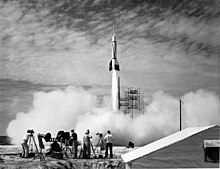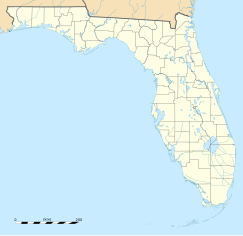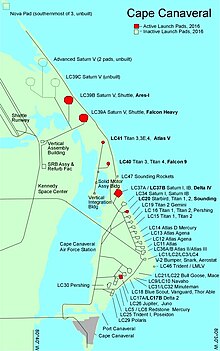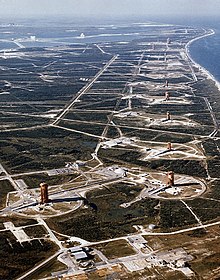Cape Canaveral Space Force Station
| Cape Canaveral Space Force Station | ||
|---|---|---|
| National Register of Historic Places | ||
| Historic District | ||
| National Historic Landmark | ||
|
|
||
| position | Cape Canaveral , Brevard County , Florida | |
| coordinates | 28° 29′ 20″ N , 80° 34′ 40″ W | |
| Built | 1948 | |
| NRHP number | 84003872 | |
| Added to the NRHP | April 16, 1984 | |
| Declared as NHL | April 16, 1984 | |
Cape Canaveral Space Force Station ( CCSFS ) is a US Air Force missile launch site at Cape Canaveral , Florida , just north of Cocoa Beach . During World War II , this area was used by the Air Force as an airfield. The first rocket launches took place here in the 1950s. The first manned space flights of the USA ( Mercury , Gemini and Apollo 7 ) also started here. However, since the flight of Apollo 8 in December 1968, all US manned rockets ( Apollo program andSpace Shuttle ) in NASA 's Kennedy Space Center (KSC) to the north-west. Launches are performed in an azimuth range between 35° and 120°, resulting in orbit inclinations between 28 degrees (when launched east) to 57 degrees (when launched northeast).
story
names
In September 1948, the area around Cape Canaveral became operational as the Banana River Naval Air Station. On May 11, 1949, it was selected to expand White Sands (WSMR) launching capabilities in New Mexico .
In honor of US President John F. Kennedy , Cape Canaveral Air Force Station was renamed Cape Kennedy Air Force Station in 1964. In 1973 the base was given its old name again. However, the name was changed again in 1992: the CCAFS was called Cape Canaveral Air Station (CCAS) for eight years. In March 2000, the US Air Force changed the name back to reflect its military status. A year after the creation of the United States Space Force , another renaming to Cape Canaveral Space Force Station took place in December 2020.
operation

The first launch from Cape Canaveral took place on July 24, 1950. Bumper 8 lifted off from CCAFS Launch Complex LC-3 at 14:28 UTC. The Bumper missiles were A4 missiles captured in Germany that were augmented with an American upper stage. This first test flight on July 24 was intended to test hypersonic flight in the upper atmosphere for military purposes.
In the period from 1956 onwards, several launches were carried out with military Jupiter , Vanguard , Thor and Atlas rockets.
On January 31, 1958, the first US satellite , Explorer 1 , was launched into space on a Jupiter rocket. Based on the Redstone and Atlas rockets, Mercury was the first manned program developed under the direction of NASA , which was founded in 1958. The first manned missile ( Mercury-Redstone 3 ) was launched on May 5, 1961 with the Freedom 7 mission for ballistic flight. Based on the Titan 2 , the manned program continued with Gemini .
With the LC-34 and LC-37 , the first pure NASA launch pads for the Saturn/Apollo missions were built on the northern site. Shortly thereafter, the launch complex LC-39 on the adjacent KSC with three launch sites, of which only two were built, was planned for the Saturn V. A test of the Apollo 1 on January 27, 1967 saw a disaster on the LC-34 launch pad, killing the crew ( Virgil Grissom , Edward White and Roger Chaffee ).
Walter Schirra , Donn Eisele and Walter Cunningham took off from the LC-34 on October 11, 1968 for the first manned Apollo mission ( Apollo 7 ).
On April 16, 1984, the Air Force Station was listed as a Historic District on the National Register of Historic Places and was granted National Historic Landmark status.
launch pads
| launch pad | starting places | rocket type(s) | status | Remarks |
|---|---|---|---|---|
| Launch Complex 1 (LC-1) | 1 | snark | inactive | |
| Launch Complex 2 (LC-2) | 1 | snark | inactive | |
| Launch Complex 3 (LC-3) | 1 | Bumpers, Bomarc , Polaris , Lockheed X-17 | inactive | |
| Launch Complex 4 (LC-4) | 1 | Bomarc, Redstone, Matador | inactive | |
| Launch Complex 5 (LC-5) | 1 | Redstone, Jupiter | inactive | |
| Launch Complex 6 (LC-6) | 1 | Redstone, Jupiter | inactive | |
| Launch Complex 9 (LC-9) | 1 | Navaho | inactive | |
| Launch Complex 10 (LC-10) | 1 | Navaho, Alpha Draco , Jason | inactive | |
| Launch Complex 11 (LC-11) | 1 | Atlas | inactive, under construction |
becomes a test bench and later possibly a launch site for the New Glenn |
| Launch Complex 12 (LC-12) | 1 | Atlas | inactive | |
| Launch Complex 13 (LC-13) | 1 | Atlas | inactive/active |
National Historic Landmark In use as Landing Zone 1 since 2015 . |
| Launch Complex 14 (LC-14) | 1 | Atlas | inactive | |
| Launch Complex 15 (LC-15) | 1 | titanium | inactive | |
| Launch Complex 16 (LC-16) | 1 | Titan, Pershing , Terran 1 (planned) | inactive, under construction | |
| Launch Complex 17 (LC-17) | 2 | Thor, Delta | inactive | |
| Launch Complex 18 (LC-18) | 2 | Viking , Scout , Thor, Vanguard | inactive | |
| Launch Complex 19 (LC-19) | 1 | titanium | inactive | |
| Space Launch Complex 20 (SLC-20) | 2 | Titan, Aries , Super Loki , Firefly Alpha (planned) | inactive, renovation planned | |
| Launch Complex 21 (LC-21) | 2 | Goose , Mace | inactive | |
| Launch Complex 22 (LC-22) | 2 | Goose, Mace | inactive | |
| Launch Complex 26 (LC-26) | 2 | Jupiter, Redstone | inactive | National Historic Landmark |
| Launch Complex 29 (LC-29) | 2 | Polaris | inactive | |
| Launch Complex 30 (LC-30) | 5 | pershing 1 | inactive | |
| Launch Complex 31 (LC-31) | 2 | Minuteman , Pershing 1 | inactive | |
| Launch Complex 32 (LC-32) | 1 | minuteman | inactive | |
| Launch Complex 34 (LC-34) | 1 | Saturn | inactive | National Historic Landmark |
| Space Launch Complex 36 (SLC-36) | 2 | Atlas, New Glenn (planned) | in work | |
| Space Launch Complex 37 (SLC-37) | 2 | Saturn, Delta IV | active | |
| KSC Launch Complex 39 (LC-39) | 2 | Saturn, Space Shuttle , Falcon 9 , Falcon Heavy | active | |
| Space Launch Complex 40 (SLC-40) | 1 | Titan, Falcon 9 | active | |
| Space Launch Complex 41 (SLC-41) | 1 | Titan, Atlas, Vulcan (planned) | active, renovation planned | |
| Launch Complex 43 (LC-43) | 1 | Arcas , Hopi , Loki , Rocketprobe , Viper | inactive | |
| Space Launch Complex 46 (SLC-46) | 1 | Trident , Athena , Minotaur | active | |
| Launch Complex 47 (LC-47) | 1 | Loki, rocket probe | active |
web links
- Cape Canaveral Air Force Station Virtual Tour
- Launch site overview Cape Canaveral in the Encyclopedia Astronautica (English)
literature
- Martin Caidin's Spaceport USA (1959 ) describes the early days of the test site in great detail.
itemizations
- ↑ Trump Admin to Rename Two Bases for Space Force Over Military Objections . Defense One, December 7, 2020: "The bases will still be overseen by the Department of the Air Force, which also oversees the Space Force."
- ↑ NASA: Launch Sites. Retrieved August 20, 2018 (English).
- ↑ Patrick Space Force Base: Vice President Mike Pence officially changes name . clickorlando.com, December 9, 2020.
- ↑ Pence reveals name changes for Patrick and Cape Canaveral bases, astronauts for Artemis moon shot . Orlando Sentinel, December 9, 2020.
- ↑ First Cape Canaveral launch 60 years ago gave birth to 'Bumper' crop of liftoffs on collectspace on July 23, 2010
- ↑ Cape Canaveral Air Force Station in the National Register Information System. National Park Service , retrieved August 7, 2017.
- ↑ Listing of National Historic Landmarks by State: Florida. National Park Service , retrieved July 20, 2019.


